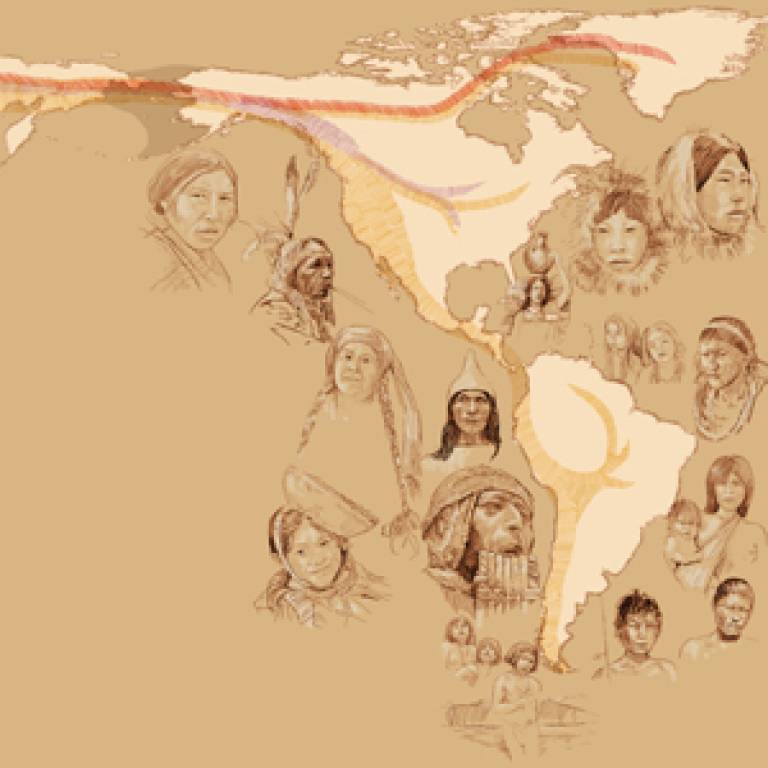Scientists have long been intrigued by the origins of Native Americans, seeking to understand their history and how they came to populate the vast continents of North and South America. Groundbreaking research has provided compelling answers, revealing that Native American populations, stretching from Canada to the tip of Chile, originated from at least three distinct migration waves. However, the vast majority are descendants of a single, primary group of First American migrants who journeyed to the Americas over 15,000 years ago.
 Beringia land bridge and early migrants
Beringia land bridge and early migrants
This pioneering group of First Americans made their way across Beringia, an ancient land bridge that once connected Asia and America during the Ice Age. This land bridge served as a crucial pathway for early human migration, allowing people to traverse from Siberia into North America. A detailed study of the DNA variations within Native American populations has illuminated this complex history. An international team of researchers discovered that while the initial migration formed the bedrock of most Native American ancestry, two subsequent migrations also contributed significantly to the genetic tapestry, particularly in specific regions. The findings of this comprehensive study were published in the prestigious journal Nature.
Professor Andres Ruiz-Linares from UCL Genetics, Evolution and Environment, who spearheaded the study, commented, “For years, a central point of contention has been whether the Americas were populated through a single migration or multiple waves from Siberia. Our research definitively resolves this debate: Native Americans are not the product of a singular migration event. Furthermore, our work sheds light on the patterns of human dispersal within the Americas themselves.”
This ambitious research endeavor stands as the most extensive survey of genetic diversity among Native Americans to date. The team meticulously analyzed data from 52 Native American groups and 17 Siberian populations. They scrutinized over 300,000 specific DNA sequence variations, known as Single Nucleotide Polymorphisms (SNPs), to map out the intricate genetic relationships and differences among these diverse populations.
The second and third migration waves, while less pervasive than the first, left their genetic imprint primarily on Arctic populations speaking Eskimo-Aleut languages and the Canadian Chipewyan, who speak a Na-Dene language. Intriguingly, even these groups predominantly inherited their genetic makeup from the initial First American migration. Eskimo-Aleut speakers derive over half of their DNA from First Americans, while the Chipewyan inherit approximately 90%. This genetic pattern underscores that these later migrations from Asia interacted and intermixed with the First Americans they encountered upon arriving in North America, leading to a blending of ancestries.
Professor David Reich, a co-author of the study and genetics expert at Harvard Medical School, emphasized the depth of Native American lineages, stating, “There are at least three deep lineages within Native American populations. The Asian lineage that gave rise to First Americans is the most anciently diverged. In contrast, the Asian lineages that contributed DNA to Eskimo-Aleut speakers and the Na-Dene-speaking Chipewyan of Canada are more closely related to contemporary East Asian populations.”
The study further revealed insights into the dispersal patterns of early Americans once they reached the continent. The evidence suggests a rapid southward expansion along the coast, with populations branching off along the way. Remarkably, after these initial separations, there appears to have been limited gene flow between different Native American groups, particularly in South America, indicating relative isolation following the initial dispersal.
However, the researchers uncovered two notable exceptions to this general pattern of dispersal and isolation. Firstly, the Chibchan-speaking people of Central America exhibit genetic ancestry from both North and South America. This suggests a fascinating back-migration from South America into Central America, resulting in a genetic admixture of two previously separated strands of Native American ancestry. Secondly, the Naukan and coastal Chukchi populations of northeastern Siberia were found to carry ‘First American’ DNA. This surprising finding indicates a reverse migration, with Eskimo-Aleut speakers migrating back into Asia, carrying with them genetic markers of their Native American heritage.
Analyzing the genetic history of Native Americans presented significant technical hurdles due to the extensive intermingling with European and African populations following 1492. Centuries of genetic mixing complicated the task of isolating and studying purely Native American genetic lineages. To overcome this challenge, the research team developed innovative methods that allowed them to specifically analyze the segments of the genome that were exclusively of Native American origin.
Professor Ruiz-Linares highlighted the complexity of the research, stating, “The study of Native American populations is technically very challenging because of the widespread occurrence of European and African mixture in Native American groups.” Professor Reich further elaborated on their methodological breakthrough: “We developed a method to peel back this mixture, allowing us to investigate the relationships among Native Americans before the arrival of Europeans and Africans. This advancement enabled us to study the history of a significantly larger number of Native American populations than previously possible.”
The sheer scale and diversity of DNA samples analyzed in this study were made possible through the collaborative efforts of a vast international team comprising 64 researchers. These researchers hailed from across the Americas, Europe, and Russia, representing institutions in Argentina, Bolivia, Brazil, Canada, Chile, Colombia, Costa Rica, Guatemala, Mexico, Peru, Russia, the USA, England, France, Spain, and Switzerland. This global collaboration underscores the immense effort and resources required to unravel the intricate story of where Native Americans truly came from and their remarkable journey across the Americas.

